
Question Number 211235 by behi834171 last updated on 01/Sep/24
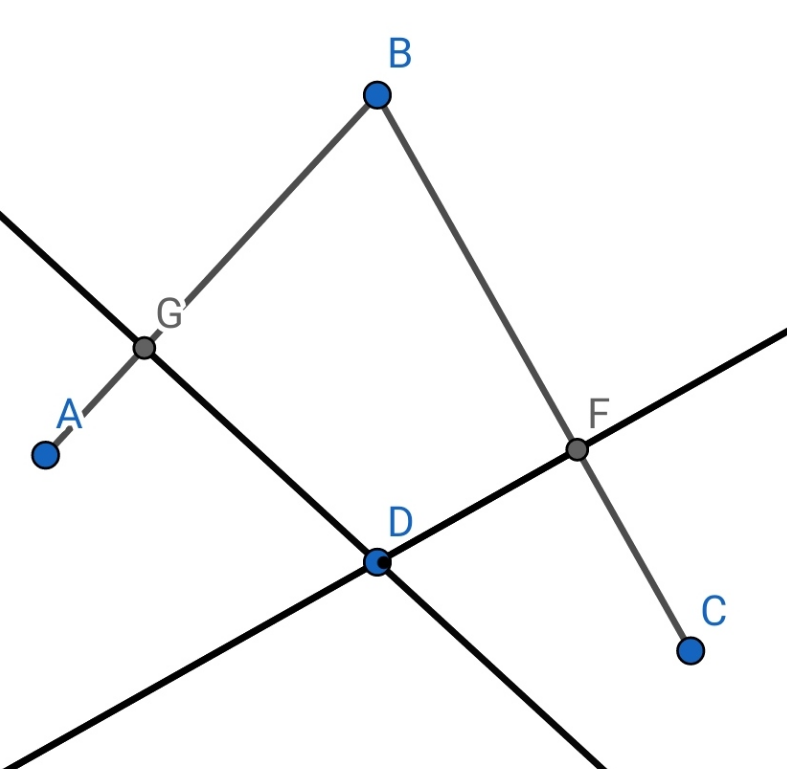
Commented by behi834171 last updated on 01/Sep/24
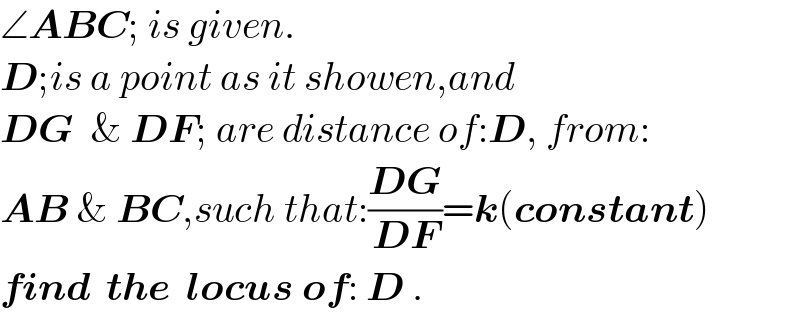
$$\angle\boldsymbol{{ABC}};\:{is}\:{given}. \\ $$$$\boldsymbol{{D}};{is}\:{a}\:{point}\:{as}\:{it}\:{showen},{and} \\ $$$$\boldsymbol{{DG}}\:\:\&\:\boldsymbol{{DF}};\:{are}\:{distance}\:{of}:\boldsymbol{{D}},\:{from}: \\ $$$$\boldsymbol{{AB}}\:\&\:\boldsymbol{{BC}},{such}\:{that}:\frac{\boldsymbol{{DG}}}{\boldsymbol{{DF}}}=\boldsymbol{{k}}\left(\boldsymbol{{constant}}\right) \\ $$$$\boldsymbol{{find}}\:\:\boldsymbol{{the}}\:\:\boldsymbol{{locus}}\:\boldsymbol{{of}}:\:\boldsymbol{{D}}\:. \\ $$
Answered by A5T last updated on 01/Sep/24
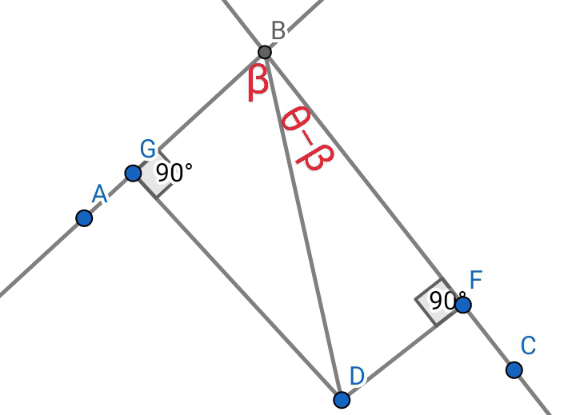
Commented by A5T last updated on 01/Sep/24
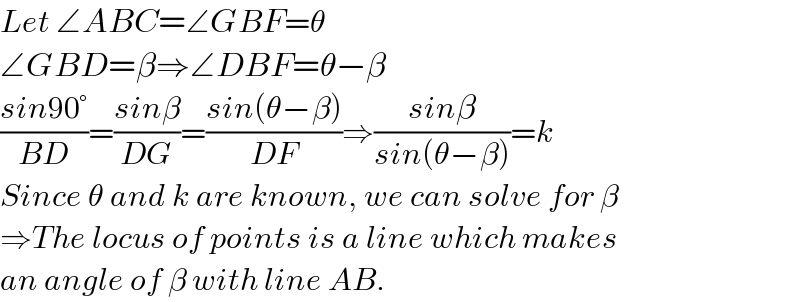
$${Let}\:\angle{ABC}=\angle{GBF}=\theta \\ $$$$\angle{GBD}=\beta\Rightarrow\angle{DBF}=\theta−\beta \\ $$$$\frac{{sin}\mathrm{90}°}{{BD}}=\frac{{sin}\beta}{{DG}}=\frac{{sin}\left(\theta−\beta\right)}{{DF}}\Rightarrow\frac{{sin}\beta}{{sin}\left(\theta−\beta\right)}={k} \\ $$$${Since}\:\theta\:{and}\:{k}\:{are}\:{known},\:{we}\:{can}\:{solve}\:{for}\:\beta \\ $$$$\Rightarrow{The}\:{locus}\:{of}\:{points}\:{is}\:{a}\:{line}\:{which}\:{makes} \\ $$$${an}\:{angle}\:{of}\:\beta\:{with}\:{line}\:{AB}.\: \\ $$
Commented by behi834171 last updated on 01/Sep/24

$${Thank}\:{you}\:{sir}\:{AST}. \\ $$$${yes}.{the}\:{locus}\:{is}\:{a}\:{line}\:{crosses}\:{at}\:{B}\:{point}. \\ $$
Answered by mr W last updated on 01/Sep/24
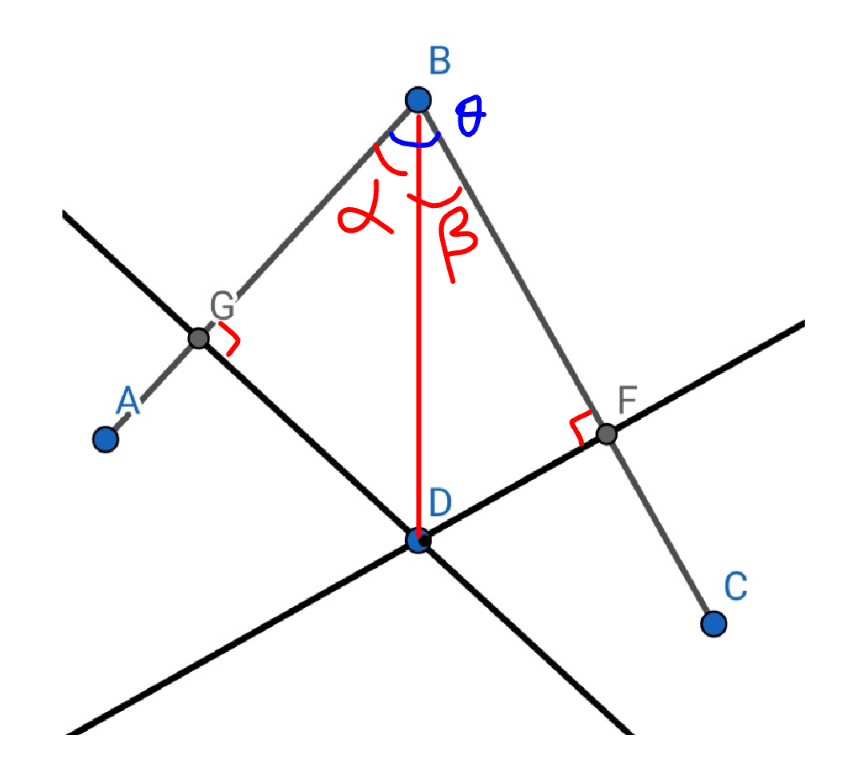
Commented by mr W last updated on 01/Sep/24
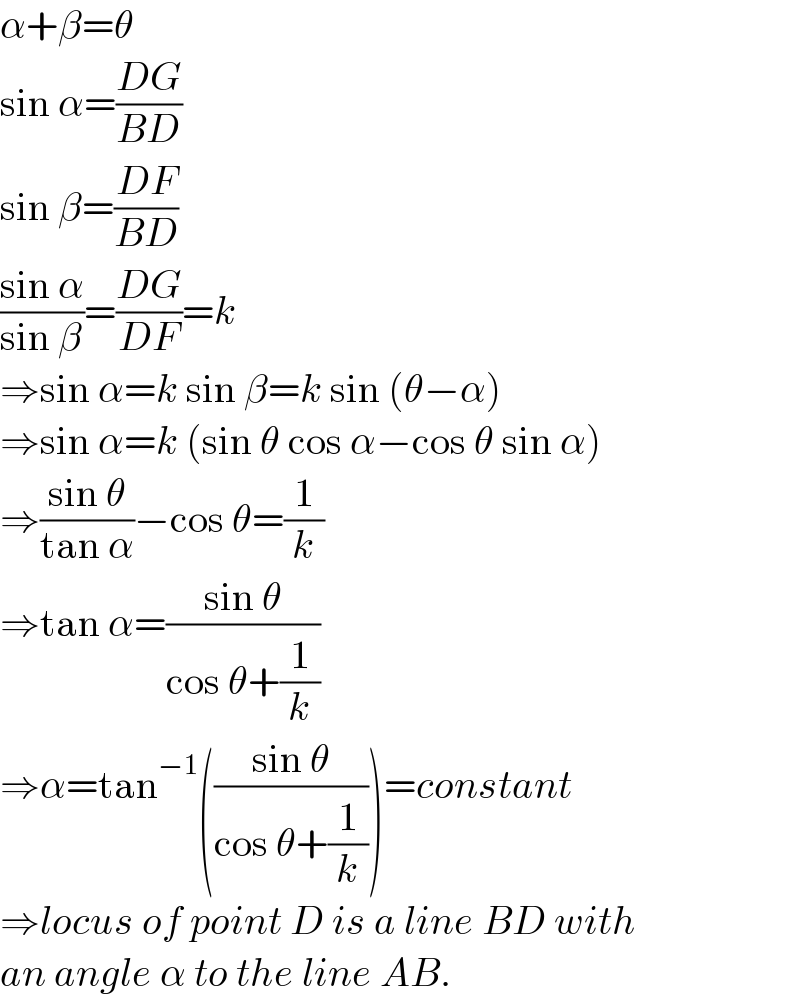
$$\alpha+\beta=\theta \\ $$$$\mathrm{sin}\:\alpha=\frac{{DG}}{{BD}} \\ $$$$\mathrm{sin}\:\beta=\frac{{DF}}{{BD}} \\ $$$$\frac{\mathrm{sin}\:\alpha}{\mathrm{sin}\:\beta}=\frac{{DG}}{{DF}}={k}\: \\ $$$$\Rightarrow\mathrm{sin}\:\alpha={k}\:\mathrm{sin}\:\beta={k}\:\mathrm{sin}\:\left(\theta−\alpha\right) \\ $$$$\Rightarrow\mathrm{sin}\:\alpha={k}\:\left(\mathrm{sin}\:\theta\:\mathrm{cos}\:\alpha−\mathrm{cos}\:\theta\:\mathrm{sin}\:\alpha\right) \\ $$$$\Rightarrow\frac{\mathrm{sin}\:\theta}{\mathrm{tan}\:\alpha}−\mathrm{cos}\:\theta=\frac{\mathrm{1}}{{k}} \\ $$$$\Rightarrow\mathrm{tan}\:\alpha=\frac{\mathrm{sin}\:\theta}{\mathrm{cos}\:\theta+\frac{\mathrm{1}}{{k}}} \\ $$$$\Rightarrow\alpha=\mathrm{tan}^{−\mathrm{1}} \left(\frac{\mathrm{sin}\:\theta}{\mathrm{cos}\:\theta+\frac{\mathrm{1}}{{k}}}\right)={constant} \\ $$$$\Rightarrow{locus}\:{of}\:{point}\:{D}\:{is}\:{a}\:{line}\:{BD}\:{with} \\ $$$${an}\:{angle}\:\alpha\:{to}\:{the}\:{line}\:{AB}. \\ $$
Commented by behi834171 last updated on 01/Sep/24

$${Thank}\:{you}\:{so}\:{much}\:{dear}\:{master}. \\ $$$$ \\ $$If we have just two intersecting lines,inested of given angle:ABC; is the locus unique?
Commented by mr W last updated on 01/Sep/24

$${in}\:{this}\:{case}\:{the}\:{point}\:{can}\:{be}\:{every} \\ $$$${where}\:{except}\:\left(\mathrm{0},\mathrm{0}\right). \\ $$
